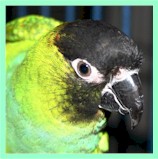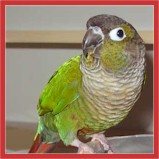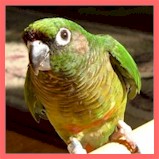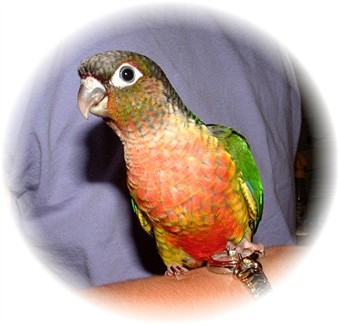|

Black Capped Conure |

Nanday Conure |

Sun Conures |

Green-Cheeked Conure |

Maroon Bellied Conure |
BREEDS & their NEEDS

CONURES
Click here
4to
go to special page dedicated to the Green-Cheek conure and their
Mutations
T here
are 8 sub-species of Conures
:
|
Aratinga |
19 species,
including the popular Sun and Mitred Conures
|
|
Pyrrhura
|
18 species, including the popular Maroon-bellied,
Green-cheeked, and Black-capped Conures |
|
Nandayus |
1 species, the Nanday Conure |
|
Leptosittaca |
1 species, the Golden-plumed Conure |
|
Ognorhynchus |
1 species, the Yellow-eared Conure |
|
Cyanoliseus |
1 species, the Patagonian Conure |
|
Enicognathus |
2 species, the Austral and the Slender-billed Conure
|
|
Guaruba |
1 species,
Guaruba guarouba,
the Golden or Queen of Bavaria Conure (formerly
Aratinga guarouba)
|
This in turn
led to birds being sold that were healthier and better
suited emotionally to captivity
by virtue of handling and
hand-feeding starting at an early age.
The
name
Conure
is applied
to many of the long-tailed parrots
The largest of all
the Conures is the
Patagonian
(Cyanoliseus
patagonus)
is generally 17"-18".
The smallest~ the
Painted Conure
(Pyrrhura
picta) is half
that size, 8.5".
The
most popular group of Conures are of the
Aratinga
genus (Sun Conure is amongst these)!
Other notable Conures include the
Austral
(Enicognathus
ferrungineus),
-
These are found
in the most southern habitat of any parrot (southern Chile).
-
The
Austral,
Patagonian,
and
Slender-billed Conures
will spend a good deal of time foraging
for food on the cage floor.
-
The
Nanday Conure
(Nandayus
nenday)
has the habit
of falling asleep on its back, feet straight up in the air
(rather
disconcerting the first time observedÖ)
-
The Queen of Bavaria Conure
(Aratinga
guarouba)
is
NOT recommended
for the first-time Conure owner because it requires a great
deal of time and attention to avert possible destructive
behaviours
Conures,
in general, are playful, intelligent, "big parrots in a little
parrot body."
They also love
to snuggle under things, so providing them with a tightly woven
wash cloth, soft piece of fabric, or fuzzy toy will be
appreciated.
The
Green Cheeks have a funny personality and can become very tame
(some of mine eat from my hand)
they aren't too noisy.
2 young Green-cheeks
Yellow-Sided Green-Cheeked
Conures
(Pyrrhura hypoxantha
)
- These are a
beautiful mutation of the Normal Green-cheek Conure (Pyrrhura
Molinae)
- Found in the
wild - in the forests and over farmland & fields of Brazil,
Bolivia, Uruguay, Paraguay and N.W. Argentina at different
altitudes.
- . Green-cheeked have oil
glands they use to preen their feathers
- So, do not create the
dust found on Cockatiels, cockatoos, and African Grey Parrots.
Allergy sufferers may be able to keep one.
Yellow-sided G.C.
- They can live to 20+ years old
I have created a separate,
detailed page dedicated to the
Yellow-Sided Green-Cheeked Conures
Click Here
^Top
|
Basic, General Facts
about Conures |
Family:
Psittacidae
Origin:
Aratinga - South and Central America, Mexico
Pyrrhura
- throughout South America
Nandayus
- south-central regions of
South America
Leptosittica
- isolated regions of
Columbia, Ecuador, and Peru
Ognorhynchus
- northern Ecuador
Cyanoliseus
- Chile, Argentina, and perhaps Uruguay
Enicognathus
- Chile, Argentina, and Tierra del Fuego (Austral); central
Chili (Slender-billed)
Guaruba
- restricted to small range of northeast Brazil
Size: 8.5-18 inches
Colouration :

Aratinga:
(Noisier species)
small to medium size; long tail; broad,
heavy bill; naked or partially feathered periophthalmic
ring; lores and cheeks fully feathered; cere either naked or
hidden by feathers with only the nares exposed; general
plumage green except for the Sun Conure subspecies, which is
predominantly yellow.
Pyrrhura (Quieter species)
small to
medium size; long tail; broad bill with notch in upper
mandible; prominent naked cere; general plumage green with
the exception of the Maroon-bellied Conure and the
Yellow-sided Conure, which show a good deal of brown.
Nandayus:
medium size; long tail; bill
longer than wider with upper mandibular notch; cere
partially feathered with nares exposed; general plumage
green.
Leptosittaca:
medium size; long tail;
partially feathered cere; conspicuous tuft of feathers
extends beyond ear coverts; general plumage green.
Ognorhynchus:
medium size; large,
heavy, bill with upper mandibular notch; elongated ear
coverts; general plumage green.
Cyanoliseus:
large size; long tail; small bill in proportion to size,
often partially covered by cheek feathers; feathered cere;
general plumage olive brown.
Enicognathus:
medium size; long tail;
disproportionately small bill; feathered cere;
characteristic edging to feathers; Slender-billed Conure has
remarkable elongated upper mandible; general plumage dull
green.
Guaruba:
medium size; long tail;
disproportionately large bill; general plumage a rich
yellow; wing coverts dark green; bill tan; legs pink.
 
Mixed Colours
Blue & Pineapple Conures |
Diet:
65-80% quality Pelleted diet is recommended if they will eat
it. Also, they
like Peanuts, Hemp, Oat meal, Paddy Rice, Buckwheat,
Safflower, Small Pine Nuts, Groats, and a small amount of
Niger, Small Sunflower and white sunflower seeds.
Remember: sunflower seeds can be addictive!
15-30% vegetables (e.g.,
greens, carrots, corn-on-the-cob), 5% fruits, and an
occasional nut, mealworm, or cricket.
Use many varieties of fruits and vegetables, washed
thoroughly.
Conures are prone to "Conure Bleeding
Syndrome",
which is thought to be caused by a lack of Vitamin K,
(see below) which
is found in foods like Broccoli.
Vit K. is the anti-dote to Warfarin (Rat Poison)
which works by thinning the blood. So Vit K helps blood
clot.
No Avocados or fruit pips
for any bird ~
Poisonous!
Iceberg lettuce, cabbage or parsley should also be
avoided.
In the wild they eat ~
Grass seeds, Fruits, Cactus, Berries, Nuts, Flowers,
Insects, and Grains.
Cage Size: The
cage should be a minimum of
18" H x 18" L x 18" W for the smaller species
up to a
minimum of 36" x 36" x 36" for the larger species.
Compatibility/Disposition
~
Conures are generally compatible with other Conures;
however, aggression may be a problem during the mating season.
Some differences in the degree of aggression exist between
genera (notably, Aratinga is reportedly more
aggressive as well as more boisterous and noisy -
Pyrrhura much quieter and
more amenable).
However, disposition is generally affectionate, peaceful and
playful, especially when socialized and handled at an early
age.
Vocalization:
Conures have a harsh and shrill screech.
Louder in the
Aratinga genus! The
Patagonian
is reported to have the loudest
call of all Conures.
They will pick up human speech with relative ease,
especially when exposed at an early age. Some owners and
breeders report the Aratinga genus will have better
enunciation while the Pyrrhura genus will develop
larger vocabularies.
Playfulness:
Highly intelligent and curious; love to cuddle; Pyrrhura
genus noted to be the consummate escape artist.
So, make sure you have secure locks on cages/Aviaries.
Life Span: Up
to 35 years
Age at Maturity:
1-3 years
(the smaller Conures mature more quickly)
Sexing:
Reliable only via DNA/Surgical Sexing ~ not visually.
Love to bathe
and will use their water bowl if nothing else is available.
Also enjoy showers.
Clever escape artists
and acrobats.
Avid chewers
(especially the Aratingas) and need to be provided
with plenty of toys/wood for this purpose or behaviour will
become destructive.
In general, the
Aratinga genus is louder, larger and more aggressive,
while the
Pyrrhura genus is
preferred as a good "first time" Conure due to its quieter
and more peaceful disposition.
|
:
Throughout the year, depending on genus and species.
When
they Breed:
They
Can start to breed during winter months. (see below for further
details).
What
Age they start to Breed:
The smaller Conures will start to Breed around 1yr old
Type of
Nest box:
Wooden, similar to Budgie/Cockatiel box
Size
of Nest box: 16"high x 8"
square made out of 1/2" ply
Av. No of
Eggs laid: 4-7 white eggs
(av.5)
Incubation
Period
: 23 days
Who
incubates the Eggs
:The
Hen incubates but the Cock will sit tight next to her, only
leaving to feed himself
+ her
Av. Fledge
Age:
7-8 weeks
Close Ring
:
12-14 days
Ring Size:
N or P
(for the Green-cheeks)
^Top
INFO
ON BREEDING by a Green-Cheeked Conure Owner/Breeder ~
John from
Merseyside - thanks!
- Conures
will breed around 1 year old.
- All my
birds are bred in a Bird Room, during winter months
- I provide
lighting ~
- Lights
come on at around 16.00 hrs in the Summer
- Winter
: 07.00hrs and go off
at 22.00 hrs.
- I
keep 1 pair in 3ft X2 ft x11/2 ft cage with the nest box
on the outside
- No
heating is given to my birds (but my Aviary is draught free,
insulated and lined)
-
I only have a Frost stat
link to a Heater-tube to prevent the water freezing solid!.
-
Each of my nest boxes
have holes cut in the top into which I can pop a wireless-led camera
-
~to observe any pair,
without disturbing them.
-
My Nest box sizes are 16
inches high 8 inches square & are made from 1/2" ply.
-
I use fine shredded
paper for nesting material / or Easibed
-
A breeding pair will lay
between 4 to 7 white eggs the average being 5.
-
Incubation is 23 days
-
The hen incubates but the cock will sit tight
next to her, only leaving to feed himself and her.
-
A few days before the eggs are due to
hatch, the hen will begin taking baths,
-
Soon the chick will peck the shell with an
egg tooth on the outside of it's beak.
-
The shell will either be thrown out or eaten
by the parents.
-
Youngsters fledge around
7/8 weeks and normally stay with their parents for a further 2
weeks.
-
If the parents lay a
2nd clutch the first round chicks must be removed as soon as
they are weaned .
-
If chicks need to be
sexed I send samples for DNA sexing
-
but only after ringing ~
normally around 12/14 days.....
-
Ring size N ~ is the
size for Green-Cheeked conures (next size up from Kakis ~ they
are M)
FEEDING
-
I
feed mine on large parakeet mix, Tropical Parrot Mix and millet
sprays and fresh fruit and veg daily,
-
Softfood ~
twice a week.
-
In the
breeding season they get a lot more soft food (E.M.P. Egg food or
similar) plus fruit and veg
-
~ some are
fussy ~ you have to try them out.
-
Conures also enjoy extra treats
such as shredded meat or pasta, hard boiled egg, peanut butter,
bean sprouts and torn up bread moistened with fruit juices.
-
Anything you eat is pretty much
okay with your Conure,
~ except for salt, butter and avocado, which is toxic
(Poisonous) to birds
-
A Conure's
diet should consist of a good quality small parrot
mix (with a good variation of seeds).
-
supplemented with various fruits, green foods, millet
spray, and occasionally some mealworms is generally regarded as
suitable.
-
Cuttlefish bone
with mineralised grit and/or oyster shell in a separate dish -
essential esp. at breeding time.
-
Vitamins can be added to the drinking water or the
food.
-
they also
enjoy : apples, grapes, many garden vegetables i.e.
spinach, watercress, field lettuce, chickweed, dandelions,
carrots, corn on the cob, peas, endive, and sweet potatoes.
-
Additional proteins can be offered such as cottage
cheese, shredded cooked chicken, hardboiled eggs, peanuts.
-
Fresh, clean
water should be provided daily.
CONURES in their Wild Habitat
-
Conures are classed as either large parakeets or small
parrots; despite being rather large for parakeets.
They
are
found in the western hemisphere.
All
living conure species are found in Central and South America;
-
the extinct
(Conuropsis
carolinensis) or
Carolina Parakeet was an exception.
Conures are lightly built with long tails and small (but
deceptively strong)
beaks.
Conure
beaks always have a small cere and are usually horn-coloured or
black.
Most
Conure species live in flocks of 20 or more birds.
Nesting
Sites in the Wild: Holes carved in sandstone cliffs and
Terminate mounds or in
naturally formed tree cavities.
Diet in the wild ~
Grass seeds, Fruits, Cactus, Berries, Nuts, Flowers,
Insects, and Grains.
-
Conures
often eat grain, which causes them to be treated as
agricultural pests in some places
HEALTH
^Top
CONURE BLEEDING
SYNDROME
(something you
should really be aware of if you own a conure)
- When
conures were being imported in large numbers, some of them
developed a condition called
Conure bleeding syndrome.
-
Conure
bleeding syndrome has been documented in Blue-crowns,
Peach-fronts, Half-moons and Patagonians.
-
Affected
birds suffer episodes of internal bleeding that can eventually
kill them, if not treated in time.
-
These
birds have nosebleeds, difficulty breathing, weakness, diarrhoea
and excessive urination.
- Conure Bleeding Syndrome (CBS)
appears in conure species with rapid onset of weakness and
drowsiness.
- The patient may be bleeding
from the mouth or Cloaca.
-
The actual
cause is unknown, but a lack of vitamin K, Calcium and other
minerals in a birdís diet
may contribute to conure bleeding
syndrome.
- It was
found in tests that birds suffering from this condition had low
Blood Calcium, D3 levels.
- Also,
a problem in the Bird's bone marrow inhibits production of
healthy Red Blood Cells, which carry oxygen round the body.
- Hence,
the bird appearing tired/drowsy.
- So,
it is quite imperative that your Conure is given a varied and
healthy Diet.
-
Some
veterinary experts believe the condition is caused by a virus.
-
Vitamin
K is used as an Anti-dote to the Bleeding, as it
enables the blood to clot.
- This can
be given by injection ~ your Vet ~ who must be consulted as a
matter of URGENCY!
-
PREVENTION
is the best way forward
-
~ feed a
varied Healthy Diet rich in Vitamins and minerals inc. Vit.K and
Calcium
-
Vitamin
K is found in all Dark Green Vegetables (Broccoli, Cabbage, Brussel Sprouts
etc.)
- It
should be present in any Pelleted feed made specifically for
Conures (check the back of the
packet).
CALCIUM
- Can be
given as an additive i.e. Calcivet added to the water
- (but then
it depends on how much your birds actually drink, as to how much
they take on board)!
- or
you can add the supplement to your soft foods or onto a piece of
fruit that you know your bird WILL eat.
- Grate
Cuttlefish onto soft food or fruit
- You
can offer small piece of grated cheese (calcium is in the milk
used to make the cheese)
- ~ but bear
in mind birds, in general, are fairly "Lactose Intolerant"
- ~ so you
would only be able to offer small portions.
- Goats
milk cheese may be better.
-
With good
care, a Conure can live up to 40 years,
-
Although
the average life span of a pet Conure is about 15 years.
-
Conures
are prone to feather picking, Papillomas, and Psittacine beak
and feather disease syndrome (PBFDS).
-
Conures
fed seed-only diets can also develop a vitamin A deficiency
(respiratory problems)
-
and other
nutritional disorders.
Papillomas
- are benign tumours that can appear almost anywhere
on a birdís skin, including her foot, leg,
eyelid or preen gland.
- These
tumours, which are caused by a virus, ( bit like a wart) can
appear as small, crusty lesions,
or they may be raised growths that have a bumpy texture or small
projections.
- If a bird
has a papilloma on her Cloaca, the bird may appear to have a wet
raspberry coming out of her vent.
- Many
Papillomas can be left untreated without harm to the bird, but
some must be removed by an avian veterinarian because a bird can
pick at the growth and cause it to bleed.
Feather Plucking
-
Conure
owners, particularly those who own Nandays and Sun Conures, need
to be on the alert for
feather plucking.
-
You will
see feathers on the floor of the cage and scruffy or even bald
spots on your bird.
-
Conures
who suddenly begin picking at their feathers, especially those
under the wings, may have an
intestinal parasite called
Giardia.
-
If you
notice that your bird suddenly starts pulling her feathers out,
contact your avian vet for an evaluation.
-
Other
causes to consider include poor diet, low humidity, infrequent
baths, and lack of access to regular periods of light.
-
Psychological causes for feather picking can include boredom,
insecurity, breeding frustrations, nervousness,
and stress - which covers a multitude of "sins"!
^Top
-
Conures are fairly
easy to breed.
-
They must first
adapt themselves to their environment/Aviary before they will
breed.
-
Once they do
breed, however, they will continue to breed year after year.
-
Due to the
destruction of their natural habitats, all conures shall ideally
be breed in captivity to insure continuation of each species.
-
Smaller conure
species are ready to breed at 1+ years and the larger at 3
1/2 to
4 years.
-
The sex of
most conures is difficult to determine by physical
characteristics alone even if you are an experienced breeder.
-
In some birds sex
can be determined by iris colouring
-
females having red
while males have black,
-
and in several
birds sexes can be distinguished by differences in the
coloration of their plumage.
-
Pelvic bones may
be closer on a male and wider on the female (similar to
Lovebirds).
-
The sex on all
others must be determined by either a surgical probe, endoscopy,
which can be
done by many Avian vets
-
DNA testing,
usually a blood sample or a few plucked feathers sent to be
diagnosed in a lab.
or a chromosomal analysis.
-
They will need a
nest box placed up high that is filled 2/3's full with pine
shavings, peat, or other soft materials.
-
Metal nesting
boxes are nice as conures will often chew wooden ones.
-
Both
Pyrrhura (green-cheek + maroon bellied etc.and
Aratinga (Sun Conures + Nandays)
need a nest box that is approx 12"x12"x12" (30 x 30 x 30
cm).
-
Humidity is
best at between 50 - 55%.
-
After mating,
the female will spend a lot of time in the box.
-
Hen lays an
egg every other day until she has laid between 3 to 8 eggs.
-
She will brood
for approximately 27days.
-
The young will
leave the nest when they are about 50 days old.
|









